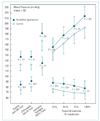Abstract
Behavioral modification is an essential component for the management of hypertension, and exercise is an important element to reduce blood pressure. For hypertensive patients, endurance exercise makes systolic blood pressure higher than in normal persons without a change in diastolic blood pressure. Exercise can reduce blood pressure by decreasing the norepinephrine level, increasing vasorelaxing materials, and improving hyperinsulinemia. Before prescribing exercise for patients with hypertension, exercise stress test should be done for men over 40, women over 50, and those who have 2 or more risk factors of coronary artery diseases (male, diabetes mellitus, hyperlcholesterolemia, family history of coronary artery disease, and smoking). There are 4 components in exercise prescription: aerobic; frequency 3~7 times/week, duration 20~60 minutes; and intensity 50~85% of VO2max. After 3 or 4 months of well-controlled blood pressure with regular exercise, the antihypertensive drugs can be tapered gradually.
References
1. Parker FC, Croft JB, Cresanta JL, Freedman DS, Burke GL, Webber LS, Berenson GS. The association between cardiovascular response tasks and future blood pressure levels in children: Bogalusa heart study. Am Heart J. 1987. 113:1174–1179.

2. Tanaka H, Safar ME. Influence of lifestyle modification on arterial stiffness and wave reflections. Am J Hyperten. 2005. 18:137–144.

3. Gottdiener JS, Brown J, Zoltick J, Ross D. Left Ventricular Hypertrophy in Men with Normal Blood Pressure: Relation to Exaggerated Blood Pressure Response to Exercise. Ann Intern Med. 1990. 112:161–166.

4. Kaufman FL, Hughson OL, Schaman IP. Effect of exercise on recovery blood pressure in normotensive and hypertensive subjects. Med Sci Sports. 1987. 19:17–20.

5. Miller DD, Ruddy TD, Zusman RM, Okada RD, Strauss HW, Boucher CA, et al. Left ventricular ejection fraction response during exercise in asymptomatic systemic hypertension. Am J Cardiol. 1987. 59:409–413.

6. Hagberg JM, Seals DR. Exercise training and hypertension. Acta Med Scand Suppl. 1986. 711:131–136.

7. Hagberg JM. Bouchard C, editor. Exercise, fitness and hypertension. Exercise, fitness and health: A Consensus of Current Knowledge. 1990. Champaign, IL: Human Kinetics Books.
8. Cook NR, Cohen J, Hebert PR, Taylor JO, Hennekens CH. Implications of small reductions in diastolic blood pressure for primary prevention. Arch Intern Med. 1995. 155:701–709.

9. Himeno E, Nishino K, Okazaki T, Nanri H, Ikeda M. A weight reduction and weight maintenance program with long-lasting improvement in left ventricular mass and blood pressure. Am J Hyperten. 1999. 12:682–690.

10. Kelemen MH, Effron MB, Valenti SA, Stewart KJ. Exercise training combined with antihypertensive drug therapy: Effects on lipids, blood pressure, and left ventricular mass. JAMA. 1990. 263:2766–2771.

11. Winder WW, Hickson RC, Hagberg JM, Ehsani AA, McLane JA. Training-induced changes in hormonal and metabolic responses to submaximal exercise. J Appl Physiol. 1979. 46:766–771.

12. Overton JM, VanNess JM, Takata HJ. Effects of chronic exercise on blood pressure in Dahl salt-sensitive rats. Am J Hypertens. 1998. 11:73–80.

13. Duncan JJ, Farr JE, Upton SJ, Hagan RD, Oglesby ME, Blair SN. The effects of aerobic exercise on plasma catecholamines and blood pressure in patients with mild essential hypertension. JAMA. 1985. 254:2609–2613.





 PDF
PDF ePub
ePub Citation
Citation Print
Print






 XML Download
XML Download